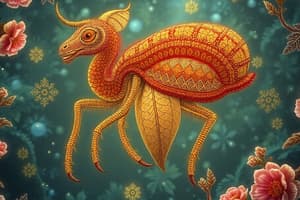Podcast
Questions and Answers
What is the main characteristic feature of Platyhelminthes?
What is the main characteristic feature of Platyhelminthes?
- Presence of a true internal cavity
- Radial symmetry
- Triploblastic with three layers of cells (correct)
- Segmented cylindrical body
Which phylum consists of roundworms with a false body cavity?
Which phylum consists of roundworms with a false body cavity?
- Phylum Platyhelminthes
- Phylum Arthropoda
- Phylum Nematoda (correct)
- Phylum Annelida
What is a distinguishing feature of Annelids?
What is a distinguishing feature of Annelids?
- Radial symmetry
- True body cavity (correct)
- Presence of jointed appendages
- Segmented cylindrical body
Which phylum is known for animals with jointed legs?
Which phylum is known for animals with jointed legs?
Which phylum includes both free-living and parasitic organisms?
Which phylum includes both free-living and parasitic organisms?
What type of symmetry do Arthropods exhibit?
What type of symmetry do Arthropods exhibit?
Which phylum is characterized by having a typically open circulatory system?
Which phylum is characterized by having a typically open circulatory system?
What is the main characteristic that defines echinoderms?
What is the main characteristic that defines echinoderms?
Which phylum has worm-like marine animals with an open circulatory system?
Which phylum has worm-like marine animals with an open circulatory system?
What is a unique feature of Phylum Chordata?
What is a unique feature of Phylum Chordata?
Which phylum has animals with true coelom and a hard calcium carbonate skeleton structure?
Which phylum has animals with true coelom and a hard calcium carbonate skeleton structure?
What distinguishes Phylum Hemichordata from the other phyla mentioned in the text?
What distinguishes Phylum Hemichordata from the other phyla mentioned in the text?
What is the defining characteristic of animals in Kingdom Animalia?
What is the defining characteristic of animals in Kingdom Animalia?
What is a common feature of the Phylum Porifera (Sponges)?
What is a common feature of the Phylum Porifera (Sponges)?
From the given Phyla, which one exhibits a heterotrophic mode of nutrition?
From the given Phyla, which one exhibits a heterotrophic mode of nutrition?
What is the meaning of 'Coelenterata' derived from the Greek word 'kilos'?
What is the meaning of 'Coelenterata' derived from the Greek word 'kilos'?
Which Phylum in the animal kingdom is commonly known as Sponges?
Which Phylum in the animal kingdom is commonly known as Sponges?
What distinguishes Kingdom Animalia from plants regarding nutrition?
What distinguishes Kingdom Animalia from plants regarding nutrition?
Flashcards are hidden until you start studying
Study Notes
Phylum Mollusca
- Bilaterally symmetrical and triploblastic
- Less segmented body
- Well-developed organ and organ system
- Typically, open circulatory system
- Limbs are present
- Examples: Snails, Octopus
Phylum Echinodermata
- Radial symmetry and triploblastic
- Have true coelom
- Hard calcium carbonate skeleton structure
- Free-living marine animals
- Examples: Sea Urchins, Starfish
Phylum Hemichordata
- Soft, fragile, and divided into a proboscis
- Single-layered epidermis
- Worm-like marine animals with an organ-system level of organization
- Open circulatory system
- Respire through gills
- Separate sexes and external fertilization
- Development is direct
- Examples: Acorn Worms, Cephalodiscus
Phylum Chordata
- Bilaterally symmetrical, triploblastic with an organ-system level of classification
- Possess a notochord and a nerve cord
- Closed circulatory system
- Sub-phyla: Urochordata, Cephalochordata, Vertebrata
- Examples: Reptiles, Mammals
Phylum Platyhelminthes
- Dorsoventrally flattened body
- Complex and differentiated body structure
- Tissues are differentiated from three layers of cells and are triploblastic
- No true internal cavity or coelom
- Bilateral symmetry
- Either free-living (Planaria) or parasitic (liver flukes)
- Examples: Tapeworm, Planaria
Phylum Nematoda
- Cylindrical body
- Bilaterally symmetrical and triploblastic
- Pseudocoelom, a false body cavity
- Parasitic and causes diseases such as elephantiasis, ascariasis
- Examples: Ascaris, Wuchereria
Phylum Annelida
- Segmented cylindrical body
- Body is differentiated into head and tail
- Bilaterally symmetrical and triploblastic
- True body cavity
- Habitat: marine, freshwater, and land
- Examples: Earthworm, Leech
Phylum Arthropoda
- Jointed appendages
- Segmented body
- Bilaterally symmetrical
- Exoskeleton and a true body cavity
- Well-differentiated organ and organ system
- Open circulatory system, but no differentiated blood vessels
- Examples: Spiders, Butterflies, Mosquitoes
Kingdom Animalia
- Multicellular eukaryotes
- Heterotrophic mode of nutrition
- No chlorophyll or cell wall
- Classified into ten different subphyla
- Phyla: Porifera, Coelenterata (Cnidaria), Platyhelminthes, Nematoda, Annelida, Arthropoda, Mollusca, Echinodermata, Hemichordata, Chordata
Phylum Porifera
- Non-motile, multicellular organisms with a hard outer skeleton
- Porous body
- Pores on the body create a canal system for substance circulation
- Not differentiated into head and tail
- No well-developed organ or organ system
- Marine habitat
- Examples: Spongilla, Sycon
Phylum Coelenterata (Cnidaria)
- Hollow body cavity
- Body is differentiated into two ends
- Aquatic animals
- Body made of two layers of cells: inner and outer linings
- Live in colonies (corals) as well as solitary (Sea anemone)
- Examples: Hydra, Jellyfish
Studying That Suits You
Use AI to generate personalized quizzes and flashcards to suit your learning preferences.




